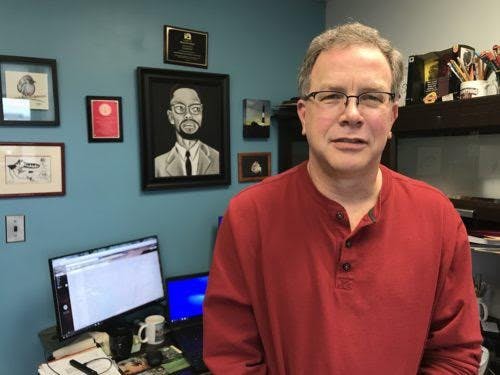Fifty percent.
That's the number of people who will be diagnosed with a mental health illness or disorder at some point in their lives, according to the Centers for Disease Control and Prevention.
65.9 million.
That's the number of visits to physician offices that resulted in a mental health diagnosis, according to that same report.
Mental health illnesses and disorders are common in our society. Yet the stigma around diagnoses, symptoms and treatment still discourages many from getting the help they deserve.
David Ewoldsen, a professor in the department of media and information who also has a Ph.D. in psychology, said that historically the media has stigmatized mental health. Within news media, things aren't getting better.
Ewoldsen said that in one of his undergraduate classes, students found that the more someone watches TV, the less stigmatized people were with mental illness. This is because when mental health is seen as more prevalent, such as in TV representation, it becomes more acceptable.

Photo courtesy David Ewoldsen
"A substantial portion of our population will suffer from mental illness at some point or another, and getting treatment and destigmatizing is going to help people more than holding it in until you have somebody or people to lean on," Ewoldsen said.
Ewoldsen said we need to understand how people use the media, television and also social media to manage their mental health.
"As a species we're remarkable about self-medicating," Ewoldsen said. "For example, people who suffer from Type 1 schizophrenia tend to also be smokers. It ends up that nicotine helps delay the onset of schizophrenic episodes, and so essentially people are self-medicating. In the same sense, people use media to self-medicate."
When someone feels anxious, they watch something that's calming. When they're feeling threatened, they'll watch something where justice is restored. Oftentimes, Ewoldsen said people use the media to try to manage mental health issues as well.
Second year doctoral student in the human development and family studies department and a clinical coordinator for the MSU Couple and Family Therapy Clinic Gianna Casaburo pursued her career path because she had this desire to support human beings and connect with others. Casaburo is also studying childhood trauma.
"Relationships help us become who we are, they help us interact in the world and you can really help individuals experience a lot of change or experience relief of some of the symptoms that they're experiencing through systemic work," Casaburo said.
"It's important for all people to feel accepted in reaching out for mental health treatment and not to feel embarrassed or ashamed."
Human development and family studies doctoral student Gianna Casaburo
She has seen a large push to increase awareness of mental health in the media lately, especially during the COVID-19 pandemic as there's been an increase in how the mental health of individuals is being affected during this time.
However, she said she does believe that people still may be afraid to seek mental health treatment because of the stigma.
"I really think it's important for all people to feel accepted in reaching out for mental health treatment and not to feel embarrassed or ashamed," Casaburo said. "Because we all struggle with something and it's important to recognize that you don't necessarily have to struggle alone, but there are people that you can reach out to and connect with and feel supported by."
Casaburo said that a part of increasing awareness of mental health treatment is increasing access to mental health treatment as some people may not even recognize the services around them that they have access to. If someone's family does not speak about mental health or if the person lacks exposure to mental health treatment, it can be really scary to seek out.

Photo courtesy Gianna Casaburo
"Using our voice to increase awareness, I think that can help people feel a sense of safety in taking that step to make that phone call or look up a mental health service online," Casaburo said.
Casaburo encourages students that if they find themselves in a place in which they are really struggling to reach out to support, to get connected with services at MSU or find someone who they feel comfortable talking with that may be able to support them in their next steps.
Associate Professor in the department of advertising and public relations Nancy Rhodes said that the news media handles mental illnesses poorly. This is seen particularly with the uptick in mass shootings in the country.
Rhodes said that reporters often use broad statements and say that the mentally ill perpetrate mass shootings.
Rhodes said in fictional television programming, storylines often feed the idea that people who are mentally ill are going to do bad things. Statistically, mentally ill people are actually less likely to do violent things.
According to a WebMD report, out of 1,315 mass murders worldwide, only 11% of mass murderers had serious mental illness. The researchers also found that mass shooters in the United States were more likely to have legal histories, use recreational drugs, abuse alcohol and have histories of non-psychotic psychiatric or neurologic symptoms.
Rhodes does believe that there's been more of an effort raising awareness recently with depression and anxiety, two very common mental illnesses.


